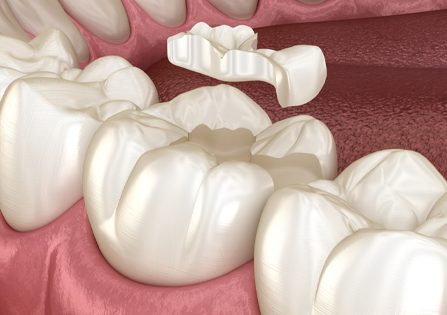
What is the difference between an Inlay and an Onlay?
An inlay replaces chunks of tooth missing, which is limited to the middle of a tooth, but not a cusp. An onlay is an extended inlay that involves replacing one or more cusps of a tooth.Inlays and onlays are the perfectionists dentist procedure who want to be the most conservative. We proudly and routinely do inlays and onlays for patients. The inlays placed in our office are almost always made of E-Max porcelain (the strongest, most easily-bonded porcelain available). An inlay is done on a tooth when too much of the tooth is broken down to be able to restore it with a conventional white filling, yet small enough that a crown is not needed. Basically, if a tooth is broken, or if a filling is very large and we have too much tooth structure missing, we remove the broken and/or decayed pieces of the tooth, we take a mold, and a piece of porcelain is crafted and bonded to the tooth to replace the “missing chunk of tooth.” This porcelain is bonded to the tooth, meaning it becomes part of the tooth, chemically and mechanically interlocked. An example that is used in our office is if you were to ship a big heavy brick in a thin cardboard box (the walls of the tooth are very thin from decay or being broken) across the country, the box would probably be broken by the time it got there.
Some patients prefer to do inlays instead of regular fillings once they are educated about the difference. There is one major advantage. So back to the drawing board…. All regular white fillings come in a paste or liquid form, and they are placed inside a cavity, molded to fit the cavity, then they are cured (hardened in place) with a blue light (curing light). When the filling is cured there is always some micro shrinkage of that material, ALWAYS, even with our Sonic Fill, which is the best tool on the market.tooth, until decay occurs again, and the filling needs to be replaced. With porcelain inlays and onlays, the lab fabricates a piece of porcelain with the space between the tooth and the porcelain, being so snug that when bonded in place, there is virtually no leakage. This means the restoration will last a longer time. Again, this goes back to our office of long lasting dentistry. It is the least expensive to do a procedure one time, the right way. Typically, a filling will last 7-15 years, and an inlay or onlay on the same patient will last 15-30 year